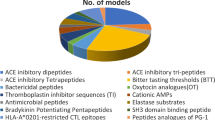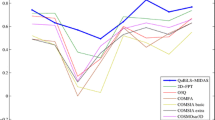Abstract
A new descriptor, called vector of topological and structural information for coded and noncoded amino acids (VTSA), was derived by principal component analysis (PCA) from a matrix of 66 topological and structural variables of 134 amino acids. The VTSA vector was then applied into two sets of peptide quantitative structure-activity relationships or quantitative sequence-activity modelings (QSARs/QSAMs). Molded by genetic partial least squares (GPLS), support vector machine (SVM), and immune neural network (INN), good results were obtained. For the datasets of 58 angiotensin converting enzyme inhibitors (ACEI) and 89 elastase substrate catalyzed kinetics (ESCK), the R 2, cross-validation R 2, and root mean square error of estimation (RMSEE) were as follows: ACEI, R 2cu ⩾0.82, Q 2cu ⩾0.77, E rmse⩽0.44 (GPLS+SVM); ESCK, R 2cu ⩾0.84, Q 2cu ⩾0.82, E rmse⩽0.20 (GPLS+INN), respectively.
Similar content being viewed by others
References
Kidera A, Konishi Y, Oka M. A statistical analysis of the physical properties of the 20 naturally occuring amino acids. J Protein Chem, 1985, 4: 23–55
Zaliani A, Gancia E. MS-WHIM scores for amino acids: A new 3D-description for peptide QSAR and QSPR studies. J Chem Inf Comput Sci, 1999, 39: 525–533
Liu S S, Cai S X, Yin C S. A novel MHDV descriptor for dipeptide QSAR studies. J Chin Chem Soc, 2001, 48: 253–260
Raychaudhury C, Banerjee A, Bag P. Topological shape and size of peptides: Identification of potential allele specific helper T cell antigenic sites. J Chem Inf Comput Sci, 1999, 39: 248–254
Anfinsen C B, Haber E, Sela M. The kinetics of formation of native ribonuclease during oxidation of the reduced polypeptide chain. Proc Natl Acad Sci USA, 1961, 47: 1309–1318
Sneath P H. Relations between chemical structure and biological activity in peptides. J Theor Biol, 1966, 12: 157–195
Hellberg S, Sjostrom M, Wold S. The prediction of bradykinin potentiating potency of pentapeptides. An example of a peptide quantitative structure-activity relationship. Acta Chem Scand, 1986, 40: 135–140
Hellberg S, Sjostrom M, Skagerberg B. Peptide quantitative structure-activity relationships, a multivariate approach. J Med Chem, 1987, 30: 1126–1135
Collantes E R, Dunn W J. Amino acid side chain descriptors for quantitative structure-activity relationship studies of peptide analogues. J Med Chem, 1995, 38: 2705–2713
Jonsson J, Eriksson L, Hellberg S. Multivariate parameterization of 55 coded and non-coded amino acids. Quant Strut-Act Relat, 1989, 8: 204–209
Sandberg M, Eriksson L, Jonsson J. New chemical descriptors for the design of biologically active peptides. A multivariate characterization of 87 amino acids. J Med Chem, 1998, 41: 2481–2491
Winer H. Structural determination of paraffin boiling point. J Am Chem Soc, 1947, 69: 2636–2641
Hosoya H. Topological index. A new proposed quantity characterizing the topological nature of structural isomers of saturated hydrocarbons. Bull Chem Soc, 1971, 44: 2332–2339
Randic M. On characterization of molecular branching. J Am Chem Soc, 1975, 97: 6609–6615
Balaban A T. High discrimination distance-based topological index. Chem Phys Lett, 1982, 89: 399–404
Kier L B, Hall L H. Molecular Connectivity in Structure-activity Analysis. New York: J Wiley & Sons, 1986
Bonchev D, Mekenjan O, Protic G. Application of topological indices to gas chromatographic data: Calculation of the retention indices of isomeric alkylbenzenes. J Chromatogr, 1979, 176: 149–156
Buydens L, Massart D L, Geerlings P. Prediction of gas chromatographic retention indexes with topological, physicochemical, and quantum-chemical parameters. Anal Chem, 1983, 55: 738–744
Call D J. Molecular connectivity in chemistry and drug research. Environ Toxicol Chem, 1995, 4: 10–19
Basak A C, Gute B D, Grunwald G D. Comparative study of topological and geometrical parameters in estimating normal boiling points and octanol/water partition coefficient. J Chem Inf Comput Sci, 1996, 36: 1054–1060
Bock A, Forchhammer K, Heider J. Selenocysteine: The 21st amino acid. Mol Microbiol, 1991, 5: 515–520
Atkins J F, Gesteland R. The 22nd amino acid. Science, 2002, 296: 1409–1410
Yan A X, Tian G L, Ye Y H. Progress in modification of bioactive peptides with non-protein amino acids and their application in the studies of structure-activity relationship. Chin J Org Chem (in Chinese), 2000, 20(3): 299–305
Chambers I, Frampton J, Goldfarb P. The structure of the mouse glutathione peroxidase gene: The selenocysteine in the active site is encoded by the termination codon TGA. EMBO J, 1986, 5: 1221–1227
Srinivasan G, James C M, Krzycki J K. Pyrrolysine encoded by UGA in archaea: Charging of a UAG-decoding specialized tRNA. Science, 2002, 296: 1459–1462
Cho S J, Zheng W, Tropsha A. Rational combinatorial library design. 2. Rational design of targeted combinatorialn peptide libraries using chemical similarity probe and the inverse QSAR approaches. J Chem Inf Comput Sci, 1998, 38: 259–268
He Y Y, Zhu F L, Zhong B L. Artificial neural networks design and implementation. Based on evolutionary computation. Control and Decision (in Chinese), 2001, 16(3): 257–262
Montana D J, Davis L. Training feedforward neural networks using genetic algorithms. In: Proceedings of the International Joint Conference on Neural Network (IJCNN), 1989
De Weijer A P, Lucasius C B, Buydens L M C. Using genetic algorithms for an artificial neural network model inversion. Chemom Intell Lab Syst, 1993, 20: 45–55
van den Bergh F, Engelbrecht A P. Training product unit networks using cooperative particle swarm optimizers. In: Proceedings of the Third Genetic and Evolutionary Computation Conference, 2001
Wang L, Pan J, Jiao L C. Immune algorithm. J Electron (in Chinese), 2000, 28(7): 74–78
De Castro L N, Von Zuben F J. The clonal selection algorithm with engineering applications. Genetic and Evolutionary Computation Conference, Las Vegas, USA, 2000. 36–37
Toma N, Endo S, Yamada K. The immune distributed competitive problem solver with major histocompatibility complex and immune network. IEEE International Conference on Systems, Man, and Cybernetics, Nashville TN USA, 2000, 3: 1865–1870
Rogers D, Hopfinger A J. Application of genetic function approximation to quantitative structure-activity relationships and quantitative structure-property relationships. J Chem Inf Comput Sci, 1994, 34: 854–866
Zhang X G. Introduction to statistical learning theory and support vector machines. Acta Automatica Sinica (in Chinese), 2000, 26(1): 32–42
Hassell C H. The Design and synthesis of new triazolo-, pyrazolo-, and pyridazo-pyridazine derivatives as inhibitors of angiotensin converting enzyme. J Chem Soc Perkin Trans I, 1984, 23: 155–162
Hellberg S, Eriksson L, Jonsson J, Lindgren F, Sjoström M, Skagerberg B, Wold S, Andrews P. Minimum analogue peptide sets (MAPS) for quantitative structure-activity relationships. Int J Pept Protein Res, 1991, 37: 414–424
Cocchi M, Johansson E. Amino acids characterization by GRID and multivariate data analysis. Quant Struct Act Relat, 1993, 12: 1–8
Li S Z, Fu B H, Wang Y Q. On structural parameterization and molecular modeling of peptide analogues by molecular electronegativity-edge vector (VMEE): Estimation and prediction for biological activity of pentapeptides. J Chin Chem Soc, 2001, 48: 937–944
Zhou P, Zhou Y, Wu S R, Tian F F, Li Z L. A new descriptor of amino acids based on the three-dimensional vector of atomic interaction field. Chin Sci Bull, 2006, 51(1): 34–39; 2006, 51(5): 524–52
Mei H, Zhou Y, Li, S Z. A new descriptor of amino acids and its application in peptide QSARs. Peptide Science, 2005, 80: 775–786
Mei H, Zhou Y, Sun L L, Li Z L. A New descriptor of amino acids and its application in peptide QSAR. Acta Phys Chim Sinica (in Chinese), 2004, 20(8): 821–825
Snider G L. Animal models of emphysema. Am Rew Respit Dis, 1986, 133: 149–150
Nomizu M, Iwaki T, Yamashita T, Inagaki Y, Asano K, Aka matsu M, Fujita T. Quantitative structure-activity relationship (QSAR) study of elastase substrates and inhibitors. Int J Pept Protein Res, 1993, 42: 216–226
Kimura T, Miyashita Y, Funatsu K. Quantitative structure-activity relationships of the synthetic substrates for elastase enzyme using nonlinear partial least squares regression. J Chem Inf Comput Sci, 1996, 36: 185–189
Zhang H X, Guo J L, Zhu J Y. Multivariate Data Analysis Methods and Applications with Few Observations (in Chinese). Xi’an: Northwest Polytechnical University Press, 2002. 30–32
Author information
Authors and Affiliations
Corresponding author
Additional information
Supported by the Foundations of National High Technology (863) Programme (Grant No. 2006AA02Z312), State New Drug Project (Grant No. 1996ND1035A01), Fok-Yingtung Educational Foundation (Grant No. 980706), State Key Laboratory of Chemo/Biosensing and Chemometrics Foundation (Grant No. KLCB005-0012), Chongqing University Innovation Fund (Grant No. CUIF030506), Chongqing Municipality Applied Science Fund (Grant No. CASF01-3-6) and Momentous Juche Innovation Fund for Tackle Key Problem Items (Grant No. MJIF 06-9-9)
Electronic supplementary material
Rights and permissions
About this article
Cite this article
Li, Z., Li, G., Shu, M. et al. A novel vector of topological and structural information for amino acids and its QSAR applications for peptides and analogues. Sci. China Ser. B-Chem. 51, 946–957 (2008). https://doi.org/10.1007/s11426-008-0040-5
Received:
Accepted:
Published:
Issue Date:
DOI: https://doi.org/10.1007/s11426-008-0040-5
Keywords
- vector of topological and structural information for coded and noncoded amino acids (VTSA)
- peptide quantitative structure activity relationship (pQSAR)
- molecular structural characterizing descriptors (MSCD)
- quantitative sequence activity modelings (QSAMs)
- angiotensin converting enzyme inhibitors (ACEI)
- elastase substrate catalyzed kinetics (ESCK)




